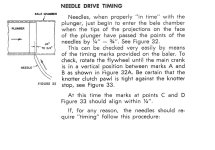countryguy1225
Silver Member
- Joined
- Oct 24, 2012
- Messages
- 119
- Location
- Fenton, Mi
- Tractor
- Kubota M6060 & L2550GST(4wd), W/ Backhoe attch. Mitsubhish MT160D (4wd) :- )
Newbie with a very long few weeks learning.
Somewhere along the first use, I Broke the knotter shear bolt, which busted a needle due to defective interlock. It is now all put back together. Spent the last two weeks going thru the manuals, I have completed knotter timing & alignments on both sides. Needle safety latch also repaired.
My question- how do you hand test the knotter with real twine loaded??
I have tried several ways and find results mixed. If you pull out a bales worth of string and tie it off.... The twine gets far too tight and shears the knotter bolt again.
If you pull out a bales worth of string and let lay loose you get slack and cross wraps and it will jam and shear the knotter or leave a mess...Or on occasion even tie a knot.
If you pull out a bales worth of string and then use a bungee cord to strap down in the chute you get the best results.... But I get also get knots that hang/stay on the bill hook tongue. But I did get multiple knots to tie and fall off too. Yea!
So.... Is it time to fire this baby up and feed hay? I understand that is what really counts. But if I shear and bust stuff again I will be really upset.
Couple items for anyone interested
I have the 268 baler manual in PDF form and the NHL knotter guide as a PDF. Willing to upload them here if I can find a files area.
This video was a big help in understanding how this all works
New holland official knotter video: Small Square Baler Knotter - YouTube
Thank you for taking the time to read and if possible : posting some help.
Somewhere along the first use, I Broke the knotter shear bolt, which busted a needle due to defective interlock. It is now all put back together. Spent the last two weeks going thru the manuals, I have completed knotter timing & alignments on both sides. Needle safety latch also repaired.
My question- how do you hand test the knotter with real twine loaded??
I have tried several ways and find results mixed. If you pull out a bales worth of string and tie it off.... The twine gets far too tight and shears the knotter bolt again.
If you pull out a bales worth of string and let lay loose you get slack and cross wraps and it will jam and shear the knotter or leave a mess...Or on occasion even tie a knot.
If you pull out a bales worth of string and then use a bungee cord to strap down in the chute you get the best results.... But I get also get knots that hang/stay on the bill hook tongue. But I did get multiple knots to tie and fall off too. Yea!
So.... Is it time to fire this baby up and feed hay? I understand that is what really counts. But if I shear and bust stuff again I will be really upset.
Couple items for anyone interested
I have the 268 baler manual in PDF form and the NHL knotter guide as a PDF. Willing to upload them here if I can find a files area.
This video was a big help in understanding how this all works
New holland official knotter video: Small Square Baler Knotter - YouTube
Thank you for taking the time to read and if possible : posting some help.
Last edited:
